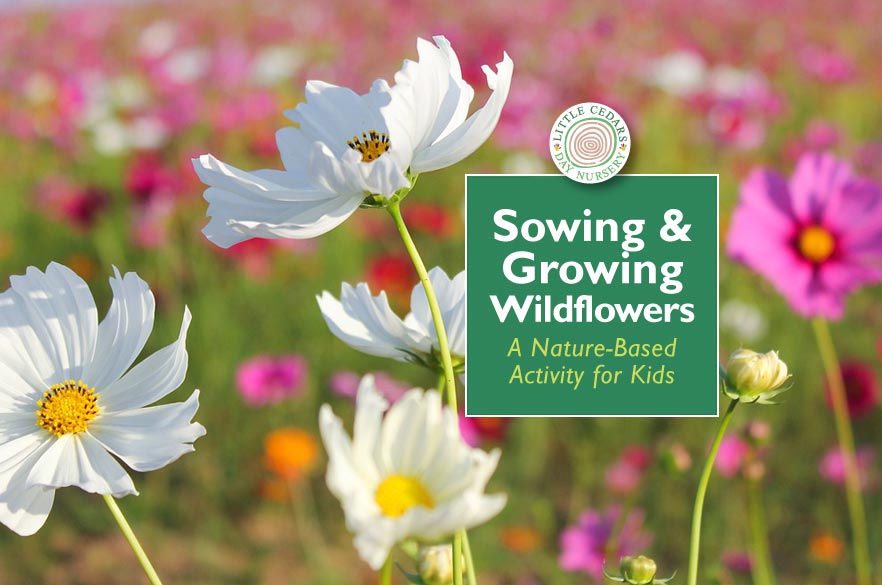
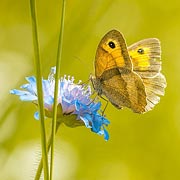 In today’s guide, we outline a simple but powerful nature-based activity that will be both fun and educational for children and under-fives. This one is all about how to sow wildflower seeds. Once growing, these will bring beauty and wonder to any setting. The activity will also complement our recent Butterfly-Spotting Activity for Kids as it should result in exactly that kind of little visitor to the child’s world — along with bees, insects, hoverflies, damselflies, and possibly even dragonflies and birds. Sowing and growing wildflowers really is very simple and the results will be beneficial in a multitude of ways. With that in mind, let’s take a look at how to approach this excellent children’s activity and learn why it’s so worthwhile.
In today’s guide, we outline a simple but powerful nature-based activity that will be both fun and educational for children and under-fives. This one is all about how to sow wildflower seeds. Once growing, these will bring beauty and wonder to any setting. The activity will also complement our recent Butterfly-Spotting Activity for Kids as it should result in exactly that kind of little visitor to the child’s world — along with bees, insects, hoverflies, damselflies, and possibly even dragonflies and birds. Sowing and growing wildflowers really is very simple and the results will be beneficial in a multitude of ways. With that in mind, let’s take a look at how to approach this excellent children’s activity and learn why it’s so worthwhile.
The Benefits of This Nature-Based Activity
This type of nature-based activity benefits everyone and everything, including the children taking part, the natural environment, little pollinators like bees and butterflies and even humanity as a whole. Let’s take a quick look at some of those benefits:
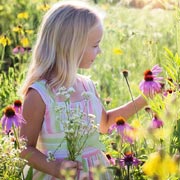 Children benefit very much from spending time in nature, as we outlined in our article entitled “Nature & Its Incredible Importance to Children” last year. There is an incredible array of benefits associated with spending time in nature, so click the bold blue link above to learn more if you haven’t already read that enlightening article.
Children benefit very much from spending time in nature, as we outlined in our article entitled “Nature & Its Incredible Importance to Children” last year. There is an incredible array of benefits associated with spending time in nature, so click the bold blue link above to learn more if you haven’t already read that enlightening article.- The activity will not only be fun for children, but it will also be educational. It’ll teach them about the circle of life, reproduction, care of the environment, care of and empathy for living things and also they will learn new skills and interests. It could even lead to a life-long hobby or career!
- The wildflowers themselves will, of course, benefit as it gives them a home and somewhere to propagate/reproduce.
- Pollinators like bees, butterflies and other insects will enjoy feeding on the pollen found in the wildflowers once they bloom. Pollen is absolutely essential to their survival.
- The pollinators are thus called because they pollinate both the wildflowers and other plants and crops. By pollinating them, it allows them to reproduce new generations. That’s essential to the natural world and all the creatures in it. Crop reproduction is also, of course, essential to our own survival.
Choosing Seeds With Your Child
Children can help with the wildflower selection process and may enjoy doing so. There are several factors that may help children decide which to grow and parents can help steer children if needed. Factors may include:
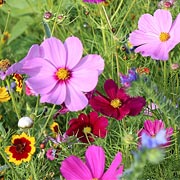 Colour(s) — Children can help decide whether to grow wildflowers of just one colour, a limited 2- or 3-colour palette or perhaps multiple colours. If parents have an existing colour theme in their garden or plant area, they may wish to point children in a particular direction, so as to keep that colour theme going.
Colour(s) — Children can help decide whether to grow wildflowers of just one colour, a limited 2- or 3-colour palette or perhaps multiple colours. If parents have an existing colour theme in their garden or plant area, they may wish to point children in a particular direction, so as to keep that colour theme going.- Type and style — Children may also take a shine to a particular type of wildflower. A good example might be poppies, which mostly have the same style of flower but are available in different sizes and colours.
- Compatibility with wildlife — Choosing wildflowers is a great opportunity to teach children that their choices have real-world effects on nature and the environment. For example, nudging children towards wildflowers that are pollinator-friendly, i.e. attracting creatures like bees and butterflies, is a great lesson to give them. It also adds an extra facet to the entire activity as they will later benefit from being able to see such adorable visitors coming to their wildflowers.
- Cost and availability — Cost and availability are additional factors as some wildflower seeds may be harder or more expensive to obtain than others. Again, parents/caregivers can explain such factors to children and it will teach them further valuable lessons.
Where to Get Seeds for Your Child
There are several places to obtain wildflower seeds and they need not cost much, if any, money:
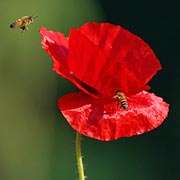 Free wildflower seeds can be harvested from existing wildflowers — either from your own wildflowers if you have them, or from those found in the wild along hedgerows and similar (N.B. only do so in moderation and for personal use). Timing will, of course, be critical because seeds will only be available at certain times of the year, i.e. when the wildflowers have “gone to seed” at the end of their flowering period.
Free wildflower seeds can be harvested from existing wildflowers — either from your own wildflowers if you have them, or from those found in the wild along hedgerows and similar (N.B. only do so in moderation and for personal use). Timing will, of course, be critical because seeds will only be available at certain times of the year, i.e. when the wildflowers have “gone to seed” at the end of their flowering period.- Seed swap schemes may also be available in your neighbourhood or, if not, perhaps a scheme could be started amongst friends or with other parents at your child’s nursery or school.
- Free or almost free seeds can sometimes be available from charities, organisations and even commercially if you get the timing right. Try a Google search for “free wildflower seeds UK” and you may be pleasantly surprised by the number of sources that will happily send you free wildflower seeds for your child to grow. Others, like Just Bee Honey, will send you free wildflower seeds if you cover the cost of postage (some simple terms apply).
- Commercially-sold wildflower seeds are also, of course, readily available to buy from local outlets, supermarkets and online. If searching online, perhaps try a search query like “wildflower seeds for children” or “bee-friendly wildflower seeds for kids” or similar. You will be met with lots of options to choose from, so filtering down to pollinator-friendly wildflower seeds and those that are suitable for children to grow will help to narrow down the huge range of choices.
Safety First
This type of activity should be supervised by a responsible adult, paying particular care regarding hazards (e.g. ponds), potentially poisonous plants/seeds, and hygiene (e.g. contaminated soil, germs, etc.). Adults can also consider teaching children about the identification and mitigation of such dangers during the activity. They will thereby also learn about self-care, personal hygiene, risk assessment and suchlike. Children and adults should wash hands etc. with soap and water following completion of this activity. Learn more safety tips for children here.
The Activity — Instructions
Once you have obtained seeds, the rest is very easy and children will enjoy and learn from taking part in the various activities involved.
Teach the Importance of Timing
Timing is an important factor because you/your child will need to plan and know when the wildflower plants and flowers will actually appear. Apart from over winter, wildflower seeds will typically take between 60 and 80 days to grow and begin blooming. Start sowing no earlier in the year than March. Mid-to-late March is good as spring will arrive around the third week of that month here in the UK and it will therefore be nicer for children outdoors. Your child can sow seeds as late in the year as mid-October or even early November if there is no snow or frost, but they should be aware that planting the seeds that late in the year mean that they will not grow until spring of the following year.
If they want to attract the most butterflies to their flowers, then a good time to sow seeds is mid-May as peak butterfly time is 60 to 80 days later.
Choosing a Location to Sow the Seeds
Wildflower seeds can be sown in flower beds, pots, containers, window boxes or indeed on lawns if a ‘wildflower meadow’ type scene is preferred. The following guidelines for sowing should help but also read any specific instructions on seed packets if these have been purchased.
Simple Option:
Sowing a Wildflower ‘Meadow’
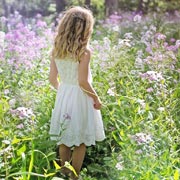 Sowing seeds on existing lawns that you/your child want as a wildflower meadow is simply a case of scattering seeds on the lawn, ideally spaced out in such a way that they don’t have to compete with each other once they start growing. Then ensure that the area of lawn is kept moist by either rain or, if there is no rain, regular sprinkling from a watering can fitted with a sprinkling head (a.k.a. ‘rose head’). Children may need to remind adults not to cut the lawn thereafter, of course!
Sowing seeds on existing lawns that you/your child want as a wildflower meadow is simply a case of scattering seeds on the lawn, ideally spaced out in such a way that they don’t have to compete with each other once they start growing. Then ensure that the area of lawn is kept moist by either rain or, if there is no rain, regular sprinkling from a watering can fitted with a sprinkling head (a.k.a. ‘rose head’). Children may need to remind adults not to cut the lawn thereafter, of course!
Advanced Option:
Sowing in Soil – Just 6 Easy Steps
For sowing in locations where there is soil rather than grass, a little preparation will be required.
- Identify your intended spot, whether that’s an area in an existing garden flower bed, flower pots or containers, window boxes or grow bags on a patio or balcony. A fairly sunny spot is recommended.
- Ensure the soil is free of weeds. Children can help with weeding, if necessary, so long as they have guidance from an adult and are mindful of safety and hygiene considerations.
- The top inch or two of soil should be loosened, for example, using a rake if it’s a flower bed.
- Help your child to sprinkle seeds evenly so they’re not spaced too close to one another, otherwise, they’ll have to compete once they start growing. Sprinkling carefully from a height will help, e.g. by raising an arm, and/or simply sprinkling one pinch at a time with care.
- Once scattered, it’s best to ensure the seeds are embedded in the soil otherwise they could be blown away or even eaten by wildlife. Therefore the soil can be patted down so it’s no longer loose. This will help keep seeds in place.
- Lastly, your child will need to be reminded to keep the area moist through regular watering, while taking care not to over-water.
Then wait for nature’s magic to happen!
Wait and Watch Out for the Wildflowers
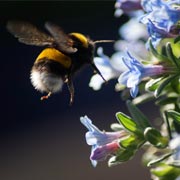 Children will love it once the wildflowers begin to grow and later bloom. They’ll also love seeing bees, butterflies, and other insects visiting and the results of the activity may indeed give them a great sense of accomplishment. The whole process and the results are quite magical when you think about it.
Children will love it once the wildflowers begin to grow and later bloom. They’ll also love seeing bees, butterflies, and other insects visiting and the results of the activity may indeed give them a great sense of accomplishment. The whole process and the results are quite magical when you think about it.
Don’t Forget — the Final Step for Children
Once the wildflowers are past the prime of their flowering stage, remind children to look out for the appearance of seeds and seed pods. You can either teach your child to leave these to self-seed for next year or help them to safely harvest the seeds. These can be stored somewhere safe and dry, ready to repeat the entire process next time.
All in all, this nature-based activity is a perfect way to demonstrate the circle of life to children.
Little Cedars Nursery, Streatham
A High-Quality Childcare Service in Streatham, Southwest London

 We hope you have found this nature-based activity useful and of interest to your little one. Little Cedars Nursery represents an outstanding choice for weekday childcare, offering a high-quality early years education for babies and children under five. We are a nursery, as well as a preschool, in Streatham, in Southwest London, so may suit families with babies, toddlers and preschoolers. We nurture all children under our care so that, by the time they leave us, they have become the very best versions of themselves and are as ‘school-ready’ as they can possibly be. We also support all Government-funded free childcare schemes.
We hope you have found this nature-based activity useful and of interest to your little one. Little Cedars Nursery represents an outstanding choice for weekday childcare, offering a high-quality early years education for babies and children under five. We are a nursery, as well as a preschool, in Streatham, in Southwest London, so may suit families with babies, toddlers and preschoolers. We nurture all children under our care so that, by the time they leave us, they have become the very best versions of themselves and are as ‘school-ready’ as they can possibly be. We also support all Government-funded free childcare schemes.
Why not arrange a guided visit with your child, so you can see the setting in action? Ask us questions, see how your little one fits in and, if you like the nursery/preschool, we’d love you to apply for a place for your child. Please select a button to get started:
While Little Cedars Nursery is based in Streatham, it’s also conveniently close for families in and around Tooting Common, Tooting, Streatham Hill, Streatham Park, Streatham Common, Furzedown, Tooting Bec, Tooting Broadway, Balham, Norbury and Colliers Wood.

